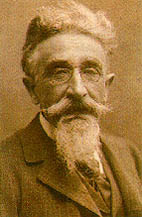José María de Pereda facts for kids
José María de Pereda (born in Polanco, Cantabria, on February 6, 1833 – died in Polanco on March 1, 1906) was an important Spanish writer. He wrote many novels about life in his home region. He was also a member of the Royal Spanish Academy, a very important group for the Spanish language.
Life and Writings
José María de Pereda went to school in Santander. In 1852, he moved to Madrid. He thought about joining the artillery corps, which is a part of the army that uses large guns. But after three years, he decided it wasn't for him.
He returned home and started writing. In 1858, he wrote articles for a local newspaper called La Abeja montañesa. He also wrote a lot for another weekly paper, El Tío Cayetano.
In 1864, he gathered his writings into a book called Escenas montañesas (Mountain Scenes). This book showed his skill at describing local life and people in a very real way.
Political Views and More Books
Pereda was against the revolution of 1868 in Spain. He wrote many articles for El Tío Cayetano to share his views. In 1871, he was chosen as a representative for Cabuérniga. He belonged to a political group called the Carlists.
In the same year, he published Tipos y paisajes, which was another collection of his "Mountain Scenes." In 1876, he released Bocetos al temple, a book with three stories. In one of these stories, he wrote about his disappointing experiences in politics.
Pereda became more and more worried about Spain's future. In his novel Don Gonzalo González de la Gonzalera (1879), he made fun of the revolution. He also criticized people who became rich quickly by using politics for their own gain.
Another writer, Pérez Galdós, wrote two novels. Pereda wrote De Tal palo tal astilla (1880) as a response. In his book, Pereda tried to show that being too open-minded about religion could be bad for countries and people.
Esbozos y rasguños (1881) was a lighter book. But El Sabor de la Tierruca (1882) was more popular. It was a beautiful description of the countryside and was liked right away.
Famous Works
Pereda tried something new with Pedro Sánchez (1883). In this book, he wrote about a person who leaves his home region. This character gets involved in politics in the capital city and becomes very disappointed.
Pereda's most famous work is Sotileza (1884). This novel gives a strong and lively picture of life by the sea. He returned to sea stories, which he loved, in La Puchera (1889).
In Peñas arriba (1895), Pereda again showed his love for country life. He created a great contrast between the healthy countryside and the unhealthy, dirty cities.
Later Life
By this time, Pereda was very famous. The rules of the Spanish Academy usually required members to live in Madrid. But they made an exception for him in 1896 because he was so important.
However, his writing career was ending. His oldest son died, and Spain faced big problems in Cuba and the Philippines during the Spanish–American War. These sad events made his last years difficult. His health got worse, and he passed away on March 1, 1906.
Pereda was part of a Spanish writing style called "realism." This style started with authors like Miguel de Cervantes. Pereda was very good at understanding people. He created characters that felt real, like Andres and Cleto in Sotileza. He also described the sea, both calm and stormy, with great power.
See also
 In Spanish: José María de Pereda para niños
In Spanish: José María de Pereda para niños


